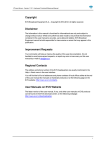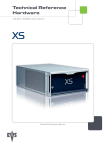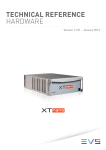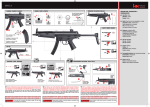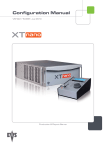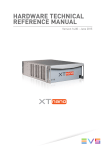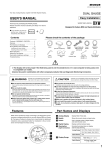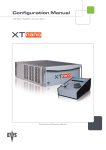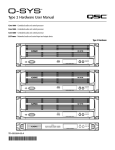Download Ethan Frome
Transcript
Technical Reference Hardware Version 10.05 - July 2011 Production & Playout Server XTnano – Version 10.05 - Hardware Technical Reference Manual EVS Broadcast Equipment SA – July 2011 Issue 10.05.C C OPYRIGHT EVS Broadcast Equipment – Copyright © 2010-2011. All rights reserved. D ISCLAIMER The information in this manual is furnished for informational use only and subject to change without notice. While every effort has been made to ensure that the information contained in this user manual is accurate, up-to-date and reliable, EVS Broadcast Equipment cannot be held responsible for inaccuracies or errors that may appear in this publication. I MPROVEMENT R EQUESTS Your comments will help us improve the quality of the user documentation. Do not hesitate to send improvement requests, or report any error or inaccuracy on this user manual by e-mail to [email protected]. R EGIONAL C ONTACTS The address and phone number of the EVS headquarters are usually mentioned in the Help > About menu in the user interface. You will find the full list of addresses and phone numbers of local offices at the following page on the EVS website: http://www.evs.tv/contacts U SER M ANUALS ON EVS W EBSITE The latest version of the user manual, if any, and other user manuals on EVS products can be found on the EVS download center, on the following webpage: http://www.evs.tv/downloadcenter I Issue 10.05.C II XTnano – Version 10.05 - Hardware Technical Reference EVS Broadcast Equipment SA – July 2011 XTnano – Version 10.05 - Hardware Technical Reference Manual EVS Broadcast Equipment SA – July 2011 Issue 10.05.C Table of Contents TABLE OF CONTENTS ................................................................................................. III WHAT’S NEW? ............................................................................................................... V 1. OVERVIEW ............................................................................................................. 1 1.1 XTNANO HIGH-RESOLUTION SERVER ....................................................................................1 1.2 UNPACKING ................................................................................................................................2 1.3 DIMENSIONS ..............................................................................................................................2 1.3.1 Video disk recorder Main frame 19 inches ..............................................................................2 1.3.2 Remote Control Panel.............................................................................................................5 1.3.3 Keyboard.................................................................................................................................5 1.4 INSTALLATION............................................................................................................................6 1.5 SAFETY, COMPLIANCE AND OPERATING CONDITIONS........................................................6 1.5.1 Safety ......................................................................................................................................6 1.5.2 EMC Standards.......................................................................................................................7 1.5.3 EMC Warning ..........................................................................................................................8 1.5.4 CE Marking .............................................................................................................................8 1.5.5 Power Supply ..........................................................................................................................9 1.6 VENTILATION & RACK MOUNTING .........................................................................................10 1.7 XTNANO SERVER MAIN SPECIFICATIONS ............................................................................11 1.7.1 Video Specifications..............................................................................................................11 1.7.2 Audio Specifications..............................................................................................................11 1.7.3 Video Codecs & Bitrates .......................................................................................................12 1.7.4 Recording Capacity for XTnano Servers...............................................................................13 1.7.5 Supported SMPTE Standards...............................................................................................13 1.7.6 Maximum Bitrate values ........................................................................................................14 1.7.7 Raid Level: 3 .........................................................................................................................14 1.7.8 Interpolation ..........................................................................................................................14 2. CABLING .............................................................................................................. 17 2.1 XTNANO REAR PANEL ............................................................................................................17 2.1.1 XTnano with COHXnano Boards ..........................................................................................17 2.1.2 XTnano with V3Xnano Boards ..............................................................................................18 2.2 GPI IN CONNECTIONS .............................................................................................................20 2.2.1 Relay Opto Inputs on the XTnano Server (GPI Inputs 1, 2, 3, 4).....................................20 2.2.2 Relay TTL Inputs on the XTnano Server (GPI Inputs 5, 6, 7, 8) ......................................20 2.2.3 TTL TTL Inputs on the XTnano Server (GPI Inputs 5, 6, 7, 8) .........................................21 2.3 GPI OUT CONNECTIONS .........................................................................................................21 2.4 MTPC GPIO CONNECTOR .......................................................................................................22 2.4.1 GPIO Connector: SUB-D 25-pin Male...................................................................................22 2.4.2 GPIO Hardware Specification ...............................................................................................23 2.5 RS422 CONNECTOR OF THE REMOTE CONTROL PANEL...................................................24 III Issue 10.05.C XTnano – Version 10.05 - Hardware Technical Reference EVS Broadcast Equipment SA – July 2011 2.6 AUDIO CONFIGURATIONS ......................................................................................................25 2.6.1 CODA FOR XTnano .............................................................................................................25 2.6.2 PIN ASSIGNMENT ON DB 15 CONNECTORS ....................................................................25 2.7 GIGABIT NETWORK .................................................................................................................27 2.7.1 Functional Overview .............................................................................................................27 2.7.2 Important Rules About Gigabit Networks ..............................................................................28 2.7.3 Switches................................................................................................................................28 3. HARDWARE DESCRIPTION................................................................................ 30 3.1 BOARDS AND SLOT CONFIGURATIONS ................................................................................30 3.1.1 Slot Configuration with COHXnano Boards ..........................................................................30 3.1.2 Slot Configuration with V3Xnano Boards ..............................................................................31 3.2 VIDEO AND REFERENCE BOARDS ........................................................................................31 3.2.1 COHXnano Boards ...............................................................................................................31 3.2.2 V3Xnano Boards “Dual Power” .............................................................................................36 3.2.3 Channel Assignment .............................................................................................................44 3.3 AUDIO CODEC BOARD ............................................................................................................45 3.4 RAID CONTROLLER BOARDS .................................................................................................46 3.4.1 HCTX board ..........................................................................................................................46 3.4.2 RTCL Board on SCSI Disk Array (with HCTX) ......................................................................49 3.4.3 RCTL Board on SAS Disk Array (with HCTX) .......................................................................51 3.5 MTPC BOARD ...........................................................................................................................53 3.5.1 Introduction ...........................................................................................................................53 3.5.2 A2/A4 Board..........................................................................................................................54 3.5.3 Memory Hole Activation ........................................................................................................56 IV XTnano – Version 10.05 - Hardware Technical Reference Manual EVS Broadcast Equipment SA – July 2011 Issue 10.05.C What’s New? The changes linked to new features in version 10.05 are listed in the table below. Click the section number in the table to jump directly to the corresponding section. In the user manual, the icon has been added on left margin to highlight information on new and updated features. Updated Sections for XTnano Version 10.05 1.7.4 SAS Disk support on XTnano: • Update of recording capacities 1.7.4 New 900 GB HDD available on internal or external storage 3.4.3 SAS Disk support on XTnano: • New section on RTCL board on SAS Disk Arrays The content of the sections mentioned below has been improved in this user manual (but no new features have been added): Section Nr Section Name 1.5.5 Electric consumption data for power supplies 1.7.2 Clear overview of available audio configurations V XTnano – Version 10.05 - Hardware Technical Reference Manual Issue 10.05.C EVS Broadcast Equipment SA – July 2011 1. Overview Welcome in the EVS range of products and thank you for using an EVS XTnano server. We will do our best to satisfy your video production needs and we look forward to continuing working with you. The EVS XTnano servers are full digital in PAL (625i), NTSC (525i), 720p, or 1080i standards. These multi-channel, disk-based video servers are ideal for a wide range of broadcast applications, from sports and live production to playout and transmission. 1.1 XTNANO HIGH-RESOLUTION SERVER The XTnano is a 4-channel HD/SD slow motion replay server from EVS. Optimized for multiple applications, such as ingestion of audio/video files, live feed recording, live slow motion and super motion, clipping and playlist playout control, XTnano offers a flexible configuration (2 cameras IN and 2 OUT for preview and program control, or 3 IN and 1 PGM). The new server natively supports DVCPRO HD and DVCPRO 50 codecs, and with its GigE networking capabilities, A/V files can be played and simultaneously transferred to other EVS servers, as well as all standard NLE and archive systems. 1 Issue 10.05.C 1.2 XTnano – Version 10.05 - Hardware Technical Reference EVS Broadcast Equipment SA – July 2011 UNPACKING On receipt of the equipment examine packing for obvious signs of damage. If damaged, do not unpack and inform the carrier immediately. Check thanks to the included packing list if all the items are present and if they show any mechanical damage. If yes, report damage or the missing parts to EVS or their appropriate representative. 1.3 DIMENSIONS 1.3.1 VIDEO DISK RECORDER MAIN FRAME 19 INCHES R ACK MOUNT 4U Weight 30 Kg/ 66.15 Lbs. Dimensions The following schemas provide the dimensions, in millimeters, of the XTnano server. 2 XTnano – Version 10.05 - Hardware Technical Reference Manual EVS Broadcast Equipment SA – July 2011 Issue 10.05.C 3 Issue 10.05.C 4 XTnano – Version 10.05 - Hardware Technical Reference EVS Broadcast Equipment SA – July 2011 XTnano – Version 10.05 - Hardware Technical Reference Manual EVS Broadcast Equipment SA – July 2011 1.3.2 Issue 10.05.C REMOTE CONTROL PANEL Weight: 3.4 Kg / 7.5 Lbs. 1.3.3 KEYBOARD Weight: 0.4 Kg / 0.9 Lbs. Weight: 0.3 Kg / 6.6 Lbs. Ref: Wacom® CTF-430 Bamboo One 5 Issue 10.05.C 1.4 XTnano – Version 10.05 - Hardware Technical Reference EVS Broadcast Equipment SA – July 2011 INSTALLATION The main power switch is located at the front side (lower right corner) of the unit. Before turning on the power, open the front door of Video disk recorder unit to check that all boards are fitted into their guides. If a board is out of its guides, remove carefully the board and replace it properly in the same slot. 1.5 SAFETY, COMPLIANCE AND OPERATING CONDITIONS 1.5.1 SAFETY This equipment has been designed and tested to meet the requirements of the following: EN 60950 European Safety of information technology equipment including business equipment. IEC 950 International Safety of information technology equipment including business equipment. In addition, this equipment has been designed to meet the following: UL 1950 - USA 6 USA Safety of information technology equipment including business equipment XTnano – Version 10.05 - Hardware Technical Reference Manual EVS Broadcast Equipment SA – July 2011 1.5.2 Issue 10.05.C EMC STANDARDS EN 55022 European Emission Standard EN 61000-3-2 European Electromagnetic Compatibility (EMC) Part 3 (Limits); Section2 ; limits for harmonic current emissions (equipment input current <16A per phase) EN 61000-3-3 European European Electromagnetic Compatibility (EMC) Part 3 (Limits), Section 3; limitation of voltage fluctuation and flicker in low-voltage supply systems for equipment with rated current of 16 A. EN 61000-4-3 European European Electromagnetic Compatibility (EMC) Part 4 (Limits), Section 3; Testing and measurement techniques - Radiated, radio-Frequency, electromagnetic field immunity test. EN 61000-4-4 European European Electromagnetic Compatibility (EMC) Part 4 (Limits), Section 4; Testing and measurement techniques - Electrical fast transient/burst immunity test. EN 61000-4-5 European European Electromagnetic Compatibility (EMC) Part 4 (Limits), Section 5; Testing and measurement techniques - Surge immunity test. EN 61000-4-6 European European Electromagnetic Compatibility (EMC) Part 4 (Limits); Section 6 ; Testing and measurement techniques - Immunity to conducted disturbances, induced by radio-frequency fields. EN 61000-4-7 European European Electromagnetic Compatibility (EMC) Part 4 (Limits), Section 7; harmonics and interharmonics measurements and instrumentation, for power supply systems and equipment connected thereto. EN 61000-4-11 European European Electromagnetic Compatibility (EMC) Part 4 (Limits); Section 11 ; Voltage dips, short interruptions and voltage variations immunity tests. EN 50082-1 European European Generic Immunity Standard – Part 1: Domestic, commercial and light industry environment. FCC USA Conducted and radiated emission limits for a Class A digital device, pursuant to the Code of Federal Regulations (CFR) Title 47 – Telecommunications, Part 15: Radio Frequency devices, subpart B-Unintentional Radiators. 7 Issue 10.05.C 1.5.3 XTnano – Version 10.05 - Hardware Technical Reference EVS Broadcast Equipment SA – July 2011 EMC WARNING Changes or modifications not expressly approved by the manufacturer for compliance could void the user's authority to operate the equipment. This equipment has been tested and found to comply with the limits for a Class B digital device, pursuant to Part 15 of the FCC Rules. These limits are designed to provide reasonable protection against harmful interference in a residential installation. This equipment generates uses and can radiate radio frequency energy and, if not installed and used in accordance with the instructions, may cause harmful interference to radio communications. However, there is no guarantee that interference will not occur in a particular installation. If this equipment does cause harmful interference to radio or television reception, which can be determined by turning the equipment off and on, the user is encouraged to try to correct the interference by one or more of the following measures: • Reorient or relocate the receiving antenna • Increase the separation between the equipment and receiver • Connect the equipment into an outlet on a circuit different from that to which the receiver is connected • Consult the dealer or an experienced radio/TV technician for help 1.5.4 CE MARKING The CE marking is affixed to indicate compliance with the following directives: • 89/336//EEC of 3 May 1989 on the approximation of the laws of the Members States to electromagnetic compatibility. • 73/23/EEC of 19 February 1973 on the harmonization of the laws of the Members States relating to electrical equipment designed for use within certain voltage limits. • 1999/5/EC of 9 March 1999 on radio equipment and telecommunications terminal equipment and the mutual recognition of their conformity. 8 XTnano – Version 10.05 - Hardware Technical Reference Manual EVS Broadcast Equipment SA – July 2011 1.5.5 Issue 10.05.C POWER SUPPLY G ENERAL D ESCRIPTION The XTnano server is fitted with two auto switching and hot-swappable power supplies. The secondary hot-swappable power supply should be connected to mains to allow automatic power switching to the second power supply should the first one fail. Important The protective earth must be connected to the ground before powering up the unit. Ensure the disk recorder unit is properly grounded at all times to avoid electrical shock hazard. S PECIFICATIONS Connection to Supply Pluggable equipment Type A (EN60950 §1.2.5): Equipment which is intended for connection to the building power supply wiring via a non- industrial plug and socket-outlet or a non-industrial appliance coupler or both. Correct mains polarity must always be observed. Do not use reversible power plugs with this equipment. Class of equipment Class 1 equipment (EN60950 § 1.2.5): electric shock protection by basic insulation and protective earth. Electric Supply Rated voltage: 115 to 240Vac (single phase) Rated frequency: 47-63 Hz Related Current: 8 A (100 to 120 Vac range) 4 A (220 to 240 Vac range) Input connector: CEE22/IEC 320 3-pin male receptacle Electric Consumption Voltage: 12 VDC (max.) Electric Current: 20 A (max.) Electric Power: 500 W 9 Issue 10.05.C XTnano – Version 10.05 - Hardware Technical Reference EVS Broadcast Equipment SA – July 2011 E NVIRONMENTAL CONDITIONS Temperature: 10°C to + 50°C (50°F to 122°F) ambient with free air flow Relative humidity: 0% to 90% (non-condensing) Cooling requirements: Forced air cooling air flow from front to back Handling/movement: Designed for fixed use when in operation Storage and transportation temperature: 0°C to +70°C (32°F to 158°F) Storage and transportation relative humidity: 0% to 90% (non-condensing) 1.6 VENTILATION & RACK MOUNTING Adequate ventilation is obviously required for optimum performance. As result of this consideration, ensure no other equipment is located close to the mainframe. Important • Remember that fans are used to air cool the equipment and protect it from overheating. • Do not block fans intakes during operations. Having regard to the weight of the XTnano chassis, support guides are required for this unit into the rack mount. The front ears of the XTnano unit are not designed to support its full weight. Applying full weight on these might result in bending the metal plate. 10 XTnano – Version 10.05 - Hardware Technical Reference Manual Issue 10.05.C EVS Broadcast Equipment SA – July 2011 1.7 XTNANO SERVER MAIN SPECIFICATIONS 1.7.1 VIDEO SPECIFICATIONS XTnano Server Standard Definition 1.7.2 High Definition 720p 50/59.94 fps Video formats 525i 59.94 fps (NTSC) 625i 60 fps (PAL) Digital interface 10-bit 4:2:2 Serial (SMPTE259M). Full frame synchronizer at input. 10-bit 4:2:2 Serial (SMPTE292M). Full frame synchronizer at input. Number of channels 4 channels, reversible REC/PLAY 4 channels, reversible REC/PLAY Monitoring & down-converters 1 CVBS or SDI (software select) per channel, with OSD 1 dedicated HD SDI output with OSD per channel Reference Analogue Black Burst Analogue Black Burst and HD Tri-Level Sync Graphics board n.a. n.a. 1080i 50/59.94 fps AUDIO SPECIFICATIONS A UDIO A NALOG AND D IGITAL C ONFIGURATIONS ON XT NANO You can request one of the following configurations with XTnano servers: Configuration 1 • 16 input and 16 output (8 pairs + 8 pairs) AES/EBU (or Dolby E) on 16 BNC connectors AND • 8 input and 8 output analogue balanced channels on 4 DB15 connectors 11 Issue 10.05.C XTnano – Version 10.05 - Hardware Technical Reference EVS Broadcast Equipment SA – July 2011 Configuration 2 • 16 input and 16 output (8 pairs + 8 pairs) AES/EBU (or Dolby E) on 4 DB15 connectors AND • 8 input and 8 output analogue balanced channels on 4 DB15 connectors O THER A UDIO S PECIFICATIONS • Up to 64 channels embedded audio (16 audio per video). • 4 additional analogue balanced output channels for monitoring. • All audio connectors on mainframe. A UDIO P ROCESSING • Uncompressed audio. • 24 bit processing and storage. • Sample rate converter from 25-55 kHz to 48 kHz. • Audio scrub. • Audio mix. 1.7.3 VIDEO CODECS & BITRATES The EVS XTnano server uses an intra-frame video encoding The XTnano server supports natively the following video codecs: Codec SD HD DVCPro HD - √ Code 8 DVCPro 50 √ - Code 9 technique. Code Protection The target bitrate of the encoded video stream can be set by the user within the accepted range: 8 to 100 Mbps for standard definition and DVCPro codecs defined bitrates for high definition. The code-protected codecs are solely available when the corresponding code is valid. Both these codecs are available by default. 12 XTnano – Version 10.05 - Hardware Technical Reference Manual Issue 10.05.C EVS Broadcast Equipment SA – July 2011 1.7.4 RECORDING CAPACITY FOR XTNANO SERVERS D ISK S TORAGE The maximum internal disk storage available on XTnano, on SCSI or SAS disks, is as follows: • 5 x 300 GB or 900 GB SCSI disks • 6 x 300 GB or 900 GB SAS disks R ECORDING C APACITY F IGURES The following table shows the recording capacity, in hours, for DVCPro 50 and DVCPro HD for: • 1 record channel, that is 1 video + 4 stereo audio tracks in SD; 1 video + 8 stereo audio tracks in HD. • with the “Operational Disk Size” parameter set to 100%. SCSI (4+1) and SAS (5+1) Disk Raid Configuration in 50 Hz / 59.94 Hz 1.7.5 # Disks Disks size (GB) # Usable disks Capacity (GB) DVCPro 50 (50Mbps) (hours) DVCPro HD (100Mbps) (hours) 5 300 4 1200 48 23 6 300 5 1500 60 29 5 900 4 3600 144 69 6 900 5 4500 180 87 SUPPORTED SMPTE STANDARDS The following standards are supported: SD SDI SMPT E 259M ( 525i 625i) HD SDI SMPT E 292M ( 720p 50 and 59.94 ; 1080i 50 and 59.94) Em bedded audio HD SMPT E 299M AES/EBU audio SMPT E 272M LT C SMPT E 12M D- VIT C SMPT E 266M Anc illar y T C in HD RP 188 13 Issue 10.05.C 1.7.6 XTnano – Version 10.05 - Hardware Technical Reference EVS Broadcast Equipment SA – July 2011 Ver tic al Anc illar y Data SMPT E 334M Mapping of Audio Metadata into Vertical Ancillary data SMPT E 2020 MAXIMUM BITRATE VALUES Those maximum values are valid for XTnano servers running Multicam version 10.03 or higher. They guarantee a smooth play and a browse at 100% speed on all channels simultaneously. DVCPro 50 DVCPro HD 1.7.7 2 ch 4 ch PAL 50 50 NTSC 50 50 PAL 100 100 NTSC 100 100 RAID LEVEL: 3 The Video Raid uses striping process across 5 disk drives. The video and audio data is striped over the first 4 drives while the parity information is saved on the fifth drive. If one drive is damaged, the Video Raid can use the parity information to recover the missing information, so that operation can continue seamlessly without bandwidth loss. For more information on online rebuild, refer to the section dedicated to this subject in the XTnano Technical Reference manual. 1.7.8 INTERPOLATION The playing back of smooth slow motion pictures carries specific issues: since some fields must be repeated at regular interval to provide the video at the playback speed required by the operator, parity violation appears regularly on the output video signal. This issue is specific to interlaced formats (525i, 625i and 1080i) and does not concern progressive formats (720p). If O and E represent respectively the odd and even fields of a standard video signal (50/60 Hz), we have: The original video signal: O E O E O E O E O E O E O E O E The output video signal at 50% speed: O O E E O O E E O O E E O O E E 14 XTnano – Version 10.05 - Hardware Technical Reference Manual EVS Broadcast Equipment SA – July 2011 Issue 10.05.C The output video signal at 33% speed: O O O E E E O O O E E E O O O E The output video signal at 25% speed : O O O O E E E E O O O O E E E E Fields with parity violation are shown in bold, underlined letters. As it appears from the above table, whatever the playback speed (with the exception of the normal 100% playback speed), a number of fields violate the normal parity of the output signal. This parity violation induces a 1-line shift of the field, resulting in a vertical jitter of the picture. The jitter frequency depends upon the chosen playback speed. To avoid this phenomenon and provide a stable output picture, EVS developed 2 types of line interpolator: the 2-line and 4-line interpolators. The interpolation process can be enabled or disabled by the operator on all EVS slow motion systems. 2- LINE I NTERPOLATOR The 2-line interpolator actually generates a new field, when the original field is in parity violation. Each line of this new field is calculated by a weighted average of the 2 neighboring lines. This process solves the problem of parity violation and vertical jitter, but the drawback is a reduction of the vertical resolution on the interpolated fields, that appear unfocused. Another by-side effect is the alternation of original fields (perfectly focused) and interpolated fields (unfocused), resulting in a "pumping" video signal. 4- LINE I NTERPOLATOR The 4-line interpolator uses a more sophisticated calculation based on the 4 neighboring lines. By using suitable coefficients for the weight of each line in the resulting calculation, we apply this interpolation to all fields. The final result is a permanently, slightly unfocused picture. The advantage is a stable output signal with no jitter and no "pumping", but the vertical bandwidth is even more reduced. The interpolator is of course always disabled at 100% playback speed, because there is no parity violation. EVS uses the same techniques with the Super Slow Motion disk recor der, working with all models of Super Motion cameras (150/180 Hz). The only difference between the processing of Super Motion and normal scan (50/60 Hz) signals is that the interpolator is always disabled at 33% playback speed, because the Super Motion signal does not cause parity violation at this particular speed. Whatever the choice, the resulting picture is thus always a compromise between stability and resolution. With EVS systems, the operator always has got the choice between any of the 3 above descr ibed techniques: no interpolation, 2- line interpolation or 4-line interpolation. Even if the operator chooses to use the interpolation, this process will be automatically disabled when not necessary (100% playback for 50/60 Hz signal, 33% and 100% playback for 150/180 Hz signal). 15 Issue 10.05.C XTnano – Version 10.05 - Hardware Technical Reference EVS Broadcast Equipment SA – July 2011 Note All professional VTRs use line interpolation in PlayVar mode to avoid vertical jitters. Default value is interpolator off for all configurations except SuperLSM configuration in which 4-line interpolator mode is enabled. 16 XTnano – Version 10.05 - Hardware Technical Reference Manual EVS Broadcast Equipment SA – July 2011 Issue 10.05.C 2. Cabling 2.1 XTNANO REAR PANEL 2.1.1 XTNANO WITH COHXNANO BOARDS The following drawing represents a rear panel of an XTnano fitted with COHXnano boards. The digital audio inputs are BNC connectors, but can also be multi -pin connectors, as represented on the drawing of the XTnano rear panel with V3Xnano boards. F ULL V IEW 17 Issue 10.05.C XTnano – Version 10.05 - Hardware Technical Reference EVS Broadcast Equipment SA – July 2011 C ONNECTORS 2.1.2 XTNANO WITH V3XNANO BOARDS The following drawing represents a rear panel of an XTnano fitted with V3Xnano boards. The digital audio inputs are multi-pin connectors, but can also be BNC connectors, as represented on the drawing of the XTnano rear panel with COHXnano boards. F ULL V IEW 18 XTnano – Version 10.05 - Hardware Technical Reference Manual EVS Broadcast Equipment SA – July 2011 Issue 10.05.C C ONNECTORS 19 Issue 10.05.C 2.2 XTnano – Version 10.05 - Hardware Technical Reference EVS Broadcast Equipment SA – July 2011 GPI IN CONNECTIONS Refer to the Multicam user manuals for the allocation of your XTnano server GPI triggers. 2.2.1 RELAY OPTO INPUTS ON THE XTNANO SERVER (GPI INPUTS 1, 2, 3, 4) 2.2.2 RELAY TTL INPUTS ON THE XTNANO SERVER (GPI INPUTS 5, 6, 7, 8) The relay must be connected between the ground and the corresponding TTL input on the DB25. 20 XTnano – Version 10.05 - Hardware Technical Reference Manual EVS Broadcast Equipment SA – July 2011 2.2.3 Issue 10.05.C TTL TTL INPUTS ON THE XTNANO SERVER (GPI INPUTS 5, 6, 7, 8) Each TTL input on the DB25 is directly connected to the pin of the TTL connector on the device triggering the GPI. The ground must be common between the DB25 connector of the XTnano and the external device. 2.3 GPI OUT CONNECTIONS The user can define the functions, types and settings associated to the GPI outs in the following applications: • Setup menu of the Remote Panel (pages 8.3 & 8.4) • IP Director settings (GPI and Auxiliary Track tab) 21 Issue 10.05.C XTnano – Version 10.05 - Hardware Technical Reference EVS Broadcast Equipment SA – July 2011 2.4 MTPC GPIO CONNECTOR 2.4.1 GPIO CONNECTOR: SUB-D 25-PIN MALE 22 1 Relay Out 4 14 Relay Out 4 2 Relay Out 3 15 Relay Out 3 3 Relay Out 2 16 Relay Out 2 4 Relay Out 1 17 Relay Out 1 5 IN + Opto 4 18 IN – Opto 4 6 IN + Opto 3 19 IN – Opto 3 7 IN + Opto 2 20 IN – Opto 2 8 IN + Opto 1 21 IN – Opto 1 9 I/O TTL 8 22 GND (Return I/O 8) 10 I/O TTL 7 23 GND (Return I/O 7) 11 I/O TTL 6 24 GND (Return I/O 6) 12 I/O TTL 5 25 GND (Return I/O 5) 13 + 5 V 50 mA max. XTnano – Version 10.05 - Hardware Technical Reference Manual EVS Broadcast Equipment SA – July 2011 2.4.2 Issue 10.05.C GPIO HARDWARE SPECIFICATION 4 X relay isolated output: • Normally open contact (power off => open). • Maximum 1 A. • Maximum 50 Volts. • Typical life time: 100.000.000 switching. 4 X opto isolated input: • The input consists in an opto diode (VF @ 1.1 Volt) in series with a 470 ohm resistor. • Typical switching point @ 1.4 mA, for secure operation: o i = 0 to 0.5 mA => opto OFF. o i = 2.5 to 30 mA => opto ON . o imax = 30 mA. • Direct connection to a TTL/CMOS signal is possible (pin opto – to GND and pin opto + to the TTL/CMOS signal). Typical switching point @ 1.6 Volts, for secure operation: o Vin < 0.8 Volts => opto OFF. o Vin > 2.2 Volts @ 2 mA => opto ON. o Vin max (without external resistor) = 15 Volts. 4 X CMOS input/output: • Each pin can be individually configured as an output or an input. • Internal 4K7 pull up resistor to +5 V. • Low level Vi < 1.5 Volt (U12 = 74HC245). • High level Vi > 3.5 Volt (U12 = 74HC245). • Optional TTL compatible level (U12 = 74HCT245). 23 Issue 10.05.C 2.5 XTnano – Version 10.05 - Hardware Technical Reference EVS Broadcast Equipment SA – July 2011 RS422 CONNECTOR OF THE REMOTE CONTROL PANEL The RS-422 cable of the Remote control panel must be wired PIN TO PIN following the above diagram. Use shielded cable to avoid electromagnetic interference on long distances. Important The Reset command from the Remote is sent through the Pin n°5 of RS-422 connector. This function should be disabled when the controller on RS-422 #1 is not an EVS controller (refer to the section ‘MTPC Board’ on page 53 of this manual). The technical specifications for the RS-422 connector are the following: • 19200 bauds • No parity • 8 data bits • 1 stop bit 24 XTnano – Version 10.05 - Hardware Technical Reference Manual Issue 10.05.C EVS Broadcast Equipment SA – July 2011 2.6 AUDIO CONFIGURATIONS 2.6.1 CODA FOR XTNANO Internal Audio Module: Embedded + AES/EBU + Analogue Balanced • Embedded Audio 24 stereo channels (input or output). • AES/EBU Audio 8 stereo inputs + 8 stereo outputs (110 Ohm balanced on SUBDB15, breakout cable with 4 XLR IN/OUT available optionally OR 75 Ohm unbalanced on BNC). • Analogue Balanced audio 4 stereo inputs + 4 stereo outputs (110 Ohm balanced on SUB-DB15, breakout cable with 4 XLR IN/OUT available optionally OR XLR). • Audio monitoring: 4 analogue balanced mono outputs (XLR). 2.6.2 PIN ASSIGNMENT ON DB 15 CONNECTORS AES DB15 Connectors Pin # 1 2 3 4 5 6 7 8 9 10 11 12 13 14 15 DB 15 #1 Inputs 1-8 (mono) GND AES input 1/2 + GND AES input 3/4 + GND AES input 5/6 + GND AES input 7/8 + AES input 1/2 GND AES input 3/4 GND AES input 5/6 GND AES input 7/8 - DB 15 #2 Inputs 9-16 (mono) GND AES input 9/10 + GND AES input 11/12 + GND AES input 13/14 + GND AES input 15/16 + AES input 9/10 GND AES input 11/12 GND AES input 13/14 GND AES input 15/16 - DB 15 #3 DB 15 #4 Outputs 1-8 (mono) Outputs 9-16 (mono) GND AES output 1/2 + GND AES output 3/4 + GND AES output 5/6 + GND AES output 7/8 + AES output 1/2 GND AES output 3/4 GND AES output 5/6 GND AES output 7/8 - GND AES output 9/10 + GND AES output 11/12 + GND AES output 13/14 + GND AES output 15/16 + AES output 9/10 GND AES output 11/12 GND AES output 13/14 GND AES output 15/16 - 25 Issue 10.05.C XTnano – Version 10.05 - Hardware Technical Reference EVS Broadcast Equipment SA – July 2011 Analogue DB15 Connectors Pin # 1 2 3 4 5 6 7 8 9 10 11 12 13 14 15 26 DB 15 #1 Inputs 1-4 (mono) GND Analogue input 1 + GND Analogue input 2 + GND Analogue input 3 + GND Analogue input 4 + Analogue input 1 GND Analogue input 2 GND Analogue input 3 GND Analogue input 4 - DB 15 #2 Inputs 5-8 (mono) GND Analogue input 5 + GND Analogue input 6 + GND Analogue input 7 + GND Analogue input 8 + Analogue input 5 GND Analogue input 6 GND Analogue input 7 GND Analogue input 8 - DB 15 #3 Outputs 1-4 (mono) GND Analogue output 1 + GND Analogue output 2 + GND Analogue output 3 + GND Analogue output 4 + Analogue output 1 GND Analogue output 2 GND Analogue output 3 GND Analogue output 4 - DB 15 #4 Outputs 5-8 (mono) GND Analogue output 5 + GND Analogue output 6 + GND Analogue output 7 + GND Analogue output 8 + Analogue output 5 GND Analogue output 6 GND Analogue output 7 GND Analogue output 8 - XTnano – Version 10.05 - Hardware Technical Reference Manual EVS Broadcast Equipment SA – July 2011 2.7 GIGABIT NETWORK 2.7.1 FUNCTIONAL OVERVIEW Issue 10.05.C The Gigabit connection makes it possible to transfer video and audio material from the XTnano server to external systems via the TCP/IP network. The external systems can be the following: • A storage system or an archiving system, such as XStore. • A non-linear editing system, such asApple Final Cut Pro . However, the external systems cannot read the raw files coming from the XTnano servers. For this reason, XT Access is used as a “gateway” between the XTnano and the IT world. Moreover, the XTnano is not able to directly send commands to the XTAccess. Consequently, a backup tool called Xtract is used as the interface to send commands to the XTAccess for file transfer operations and wrapping. XT Access is directly connected to the XTnano servers through the Gigabit network. It runs on an XP workstation and is controlled, in this context, by Xtract via XML files. 27 Issue 10.05.C XTnano – Version 10.05 - Hardware Technical Reference EVS Broadcast Equipment SA – July 2011 The Gigabit connection fulfills the following functions in relation with the XTnano servers: • Backup of clips from an XTnano server • Restore of clips to an XTnano server Please refer to the Xtract user manual for more information on the backup from and restore of clips to the XTnano, using the Gigabit network, in combination with Xtract and XTAccess. 2.7.2 IMPORTANT RULES ABOUT GIGABIT NETWORKS Gigabit networks including EVS servers need to abide by the following rules: • The hardware used on GigE networks with EVS servers need to support jumbo frames. • Both GigE ports of an EVS server need to be defined on different sub-networks. • Teaming between the GigE1 and GigE2 ports is not possible. • This is not possible to implement failover through the GigE network. • The GigE port available on the MTPC board (PC LAN) is a 100Base- T port. This is used for monitoring purposes or for the communication with other applications (LinX). This can be in the same sub-network as the GigE port. 2.7.3 SWITCHES Supported Switches All switches used on the GigE networks of EVS systems need to support jumbo frames (Ethernet frames with more than 1,500 bytes of payload). Three models of 19-inch Gigabit switches have been validated for use with EVS’ workflows: • HP Procurve 2510G-24 • Cisco Catalyst 2960G-24TC • Cisco Catalyst 3750E-24TD/3750E-48TD 28 XTnano – Version 10.05 - Hardware Technical Reference Manual Issue 10.05.C EVS Broadcast Equipment SA – July 2011 Comparison The HP Procurve 2510G-24 and Cisco Catalyst 2960G-24TC can be used for small setups where no inter-VLAN routing is needed. On larger setups, both GigE ports of the XTnano servers or/and several ports on the XF[2] are often used to increase the bandwidth or to allow redundancy. Since both GigE ports of an XTnano server cannot be used on the same sub- network, virtual LANs need to be created. To allow the transfer of packets between the virtual LANs, layer 3 switches are required. You need to select a layer 3 switch that is able to route jumbo frames. A switch of the Cisco Catalyst 3750E series should be used on larger setups as they support jumbo frames, allow traffic to be routed between different VLANs and provide stacking capabilities. The following table gives an overview on the supported switches: Model RU Layer Gb ports HP Procurve 2510G-24 1 2 2 0 (+ 4 ) Cisco Catalyst 2960G-24TC 1 2 Cisco Catalyst 3750E-24TD 1 Cisco Catalyst 3750E-48TD 1 SFP 10Gb (X2) JF switching JF routing Stacking 4 0 Y N N 20 4 0 Y N N 3 24 (u p t o 4) 2 Y Y Y 3 48 (u p t o 4) 2 Y Y Y A layer 2 device can be used when all machines are configured to be on the same LAN, when another layer 3 device is present to do the routing if needed, or when no routing between VLANs is needed. A DDITIONAL INFORMATION HP switches have a lifetime guarantee with replacement with no additional contract purchase. next-business-day advance HP switches are not compatible with Cisco's proprietary protocols (ISL, PagP, PVST, etc.) which could be a problem for integration in some legacy Cisco environment. However, such a case is quite unlikely to arise and most of the time workarounds can be found. The stacking possibilities of the Cisco 3750E series permit to have fully active LACP teams for redundancy to the hosts. 29 Issue 10.05.C XTnano – Version 10.05 - Hardware Technical Reference EVS Broadcast Equipment SA – July 2011 3. Hardware Description 3.1 BOARDS AND SLOT CONFIGURATIONS The XTnano server contains all EVS developed boards. The XTnano server can be fitted with COHXnano or V3Xnano video boards. The board configuration will slightly vary depending on the type of video board used. Important It is not allowed to mix COHXnano and V3Xnano boards on the same EVS server. 3.1.1 30 SLOT CONFIGURATION WITH COHXNANO BOARDS Slot # XTnano SD (HD Ready), HD/SD 6 MT5D board 5 HCTX 4 CODA (Audio Codec) 3 COHXnano #2 2 COHXnano #1 Genlock 1 MTPC XTnano – Version 10.05 - Hardware Technical Reference Manual EVS Broadcast Equipment SA – July 2011 3.1.2 Issue 10.05.C SLOT CONFIGURATION WITH V3XNANO BOARDS Slot # XTnano SD (HD Ready), HD/SD 6 MT5D board or RSAS 5 HCTX 4 CODA (Audio Codec) 3 V3Xnano (SD/HD) #2 2 V3Xnano (SD/HD) #1 Genlock 1 MTPC 3.2 VIDEO AND REFERENCE BOARDS 3.2.1 COHXNANO BOARDS D ESCRIPTION The COHXnano board is divided in 3 parts: COHXnano base (centre front and back), COD A module (front left), and COD B module (front right). COD A and COD B modules are the actual CODEC modules, each of them being able to be configured by software either as an encoder (for a record channel) or as a decoder (for a play channel). There are 3 hardware versions of COD modules: SD only, HD only, or HD/SD. They are clearly identified by the sticker at the front of the board. There are 2 versions of the COHXnano base: one with genlock, one without genlock. The genlock model can easily be identified by the presence of 3 quartz synthesizer at the back of the board, on the right-hand side, and by the presence of the GLK and PSU OK LEDs on either side of the DIN connec tor at the centre front of the board. Note that a COHXnano board with genlock must be installed as COHXnano #1 in first position (slot 2) in an XTnano system. A COHXnano board with genlock can never be installed in any other slot, and thus can not be used instead of COHXnano #2. Doing so will result in conflicting electrical signals inside the system. 31 Issue 10.05.C XTnano – Version 10.05 - Hardware Technical Reference EVS Broadcast Equipment SA – July 2011 B LOCK D IAGRAM J UMPERS ON THE COHX NANO BASE MODULE 32 ST1, ST2: These 2 jumpers must be installed on the COHXnano #2 board of the server. ST3 (SPARE): « parking » for jumpers for ST1 and ST2 when these are not used. ST4 (only on COHXnano with genlock) : It must be set to HiZ (or not installed). Note that the Genlock Loop connector on the back panel of the XTnano server must always be terminated with a 75 Ohm load if it is not used. ST5 : It defines the position of the board inside the server. It must be set to « 1 » for a COHXnano with genlock, and to « 2 » for a COHXnano board without genlock. XTnano – Version 10.05 - Hardware Technical Reference Manual EVS Broadcast Equipment SA – July 2011 Issue 10.05.C L EDS ON THE COHX NANO BASE MODULE WITH GENLOCK GLK Off When the genlock module is not initialized. Blinks green When the genlock module is properly initialized, but no valid genlock signal is detected. On, steady green When the module is initialized and a valid genlock signal is detected. Red (intermittent) When there is a genlock problem. Red (steady) When a resync is needed. PSU OK On (green) When all voltages are present and in the allowed range, otherwise the led is off. L EDS ON THE COD A AND COD B MODULES ( FROM LEFT TO RIGHT ) CPU Blinks green To indicate CPU activity. On, steady green When there is a problem with the processor of the COD module. PLAY On (green) When the COD module is set by the software in play mode. Off When the COD module is set in record mode. PVID On (green) When a valid video signal has been detected on the J8 connector (SD/HD SDI input), whether the COD module is in play or record mode. 33 Issue 10.05.C XTnano – Version 10.05 - Hardware Technical Reference EVS Broadcast Equipment SA – July 2011 TF (transfer) Blinks green During a data transfer between the COD module and the HCTX board M1, M2, Not currently used. M3, M4 C ONNECTORS ON THE COD A AND COD B MODULES Connector SD mode HD mode Connector label on rear panel J1 SDI/CVBS (*) monitoring output (SD) SDI/CVBS(*) monitoring output (SD, downconverted) Character Outs, CVBS/SDI J2 SDI monitoring output (SD) SDI monitoring output (SD, down-converted) Used for onboard multiviewer input J4 SDI monitoring output (SD) HD SDI monitoring output Character Outs, SD/HD (HD) J6 SDI program output (SD) HD SDI program output (HD) SD/HD Out J7 SDI program output (SD, identical to J6) HD SDI program output (HD, identical to J6) SD/HD Out J8 SDI input (SD) HD SDI input (HD) SD/HD In J9 Alternate SDI input (SD, for hardware loop) Alternate HD SDI input (HD, for hardware loop) Used for loop in (*) The switch between SDI and CVBS on J1 is done by software setting in the EVS Configuration menu. Note The loops of the input signal are not genlocked. 34 XTnano – Version 10.05 - Hardware Technical Reference Manual EVS Broadcast Equipment SA – July 2011 Issue 10.05.C L AYOUT OF C ONNECTOR P OSITIONS AND A SSIGNMENTS 35 Issue 10.05.C XTnano – Version 10.05 - Hardware Technical Reference EVS Broadcast Equipment SA – July 2011 Note Only front backplanes labelled BKP7 are compatible with COHXnano boards (4 slots for 4U frames, and 7 slots for 6U frames). The BKP7 backplanes (compatible with COHXnano boards) have 3 rows of soldering per slot, while the backplanes compatible with IO-E, COHD or COHU boards have 2 rows of soldering per slot. Note that the top slot of BKP7 backplanes must always be connected to the HCTX board. 3.2.2 V3XNANO BOARDS “DUAL POWER” Important It highly advised not to remove a V3Xnano board from the EVS server. Should you have to do so, manipulate the board very carefully, making sure it is not exposed to mechanical or electric shocks. D ESCRIPTION The V3Xnano board is divided in 3 parts: a base board identified as COHXnano base (rear section and center extension), and two modules identified as COD A V3Xnano (front left), and COD B V3Xnano (front right). The COHXnano base is the same as the COHXnano board, whereas the COD A and COD B modules are specific to the new V3Xnano board. The COD A V3Xnano and COD B V3Xnano modules are the actual CODEC modules, each of them being able to be configured by software either as an encoder (for a record channel) or as a decoder (for a play channel). The COD V3Xnano modules are SD and HD capable. From Multicam 10.04, they support the following new feature: • Full resolution 3D HD on a single V3Xnano module ( Dual Link HD SDI) There are 2 versions of the V3Xnano board: one with genlock, one without genlock. The genlock model can easily be identified by the presence of 3 quartz synthesizer at the back of the COHXnano base board, on the right-hand side, and by the presence of the GLK and PSU OK LEDs on either side of the DIN connector at the centre front of the board. Note that a V3Xnano board with genlock must be installed as V3Xnano #1 in first position (slot 2) in an XTnano server. A V3Xnano board with genlock can never be installed in any other slot, and thus cannot be used instead of V3Xnano #2. Doing so will result in conflicting electrical signals inside the system. 36 XTnano – Version 10.05 - Hardware Technical Reference Manual EVS Broadcast Equipment SA – July 2011 Issue 10.05.C B LOCK D IAGRAM J UMPERS ON THE COHX NANO B ASE OF A V3X NANO B OARD ST1, ST2: These 2 jumpers must be installed on the last V3Xnano board of the server (i.e. on V3Xnano #1 or 2 if there are respectively 1 or 2 V3Xnano boards installed in the server) ST3 (SPARE): «parking» for jumpers for ST1 and ST2 when these are not used. ST4 (only on V3Xnano with genlock) : It must be set to HiZ (or not installed). Note that the Genlock Loop connector on the back panel of the XTnano server must always be terminated with a 75 Ohm load if it is not used. 37 Issue 10.05.C XTnano – Version 10.05 - Hardware Technical Reference EVS Broadcast Equipment SA – July 2011 ST5 : It defines the position of the board inside the server. It must be set to « 1 » for a V3Xnano with genlock, and to « 2 » for a V3Xnano board without genlock. L EDS ON THE COHX NANO B ASE OF A V3X NANO BOARD WITH G ENLOCK GLK Off When the genlock module is not initialized. Blinks green When the genlock module is properly initialized, but not valid genlock signal is detected. On, steady green When the module is initialized and a valid genlock signal is detected. Red (intermittent) When there is a genlock problem. Red (steady) When a resync is needed. PSU OK On (green) When all voltages are present and in the allowed range, otherwise the led is off. L EDS ON THE V3X NANO COD A AND COD B M ODULES ( FROM L EFT TO R IGHT ) CPU Blinks green To indicate CPU activity On, steady green When there is a problem with the processor of the COD module. PLAY 38 On (green) When the COD module is set by the software in play mode. Off When the COD module is set in record mode. XTnano – Version 10.05 - Hardware Technical Reference Manual EVS Broadcast Equipment SA – July 2011 Issue 10.05.C PVID on (green) When a valid video signal has been detected on the J8 connector (SD/HD SDI input), whether the COD module is in play or record mode. TF (transfer) Blinks green While data transfers occur between the COD module and the HCTX board. M1, M2, M3, M4 Not currently used G ENERAL C ONNECTIVITY ON THE V3X NANO COD A AND COD B M ODULES This section describes the connector assignments and layout for the video standards SD 525i, SD 625i, HD 1080i and HD 720p. The specific connectivity for HD 3D Dual Link is described in a dedicated section. Changes in Connector Assignments from Multicam 10.04 On XTnano servers equipped with DualPower V3Xnano video codec boards, the assignment of video connectors on the rear panel has been modified to reflect the new configurations available from Multicam 10.04. Consequently, the following changes are applied to the connectors: • The IN 1B, IN 2B, IN 3B connectors on the rear panel can be connected to either the J1 or J3/J5 connector on the V3Xnano module. It should be connected to J1 if SD monitoring (CVBS or SDI) is required in SD or HD mode. Apply caution if you need to move the corresponding cable between J1 and J5 connectors on the V3Xnano module: do not apply excessive traction or pressure, and make sure pressure or traction is applied in the correct alignment of the connectors, never sideways. • The J3 connector, which was previously either a loop-through of the SD input or a SD down-converted version of an HD input, is the output for the left eye when working in 3D Dual Link formats from Multicam 10.04. 39 Issue 10.05.C XTnano – Version 10.05 - Hardware Technical Reference EVS Broadcast Equipment SA – July 2011 Connector Assignments in SD and HD Modes Connector J1 SD mode HD mode J3/J5 are factory-wired to the backplane instead of J1. You can connect J1 instead of J3/J5 if monitoring (CVBS or SDI) is required in SD or HD mode. J2 SDI/CVBS (*) monitoring output (SD) SDI/CVBS(*) monitoring output (SD, downconverted) SDI monitoring output (SD) SDI monitoring output (SD, down-converted) Connector label CHAR SD Not wired to the backplane. Used for onboard multiviewer input J3 Loop-through for the SDI input signal Loop-through for the SDI input signal OUT B (SD) (SD, down-converted) J4 SDI monitoring output (SD) SDI monitoring output (HD/SD) CHAR OUT SD/HD J5 N/A N/A IN B J6 SDI program output (SD) HD SDI program output (HD) OUT J7 SDI program output (SD, identical to J6) HD SDI program output (HD, identical to J6) OUT J8 SDI input (SD) HD SDI input (HD) IN J9 Alternate SDI input (SD, for hardware loop) Alternate HD SDI input (HD, for hardware loop) Used for loop in * The switch between SDI and CVBS on J1 is done by a software setting in the EVS Configuration menu. Note The loops of the input signal are not genlocked. 40 XTnano – Version 10.05 - Hardware Technical Reference Manual EVS Broadcast Equipment SA – July 2011 Issue 10.05.C Layout of Connector Positions and Assignments 41 Issue 10.05.C XTnano – Version 10.05 - Hardware Technical Reference EVS Broadcast Equipment SA – July 2011 C ONNECTIVITY ON THE V3X NANO COD A AND COD B M ODULES FOR 3D D UAL L INK Connector Assignments Connector 3D mode Connector label J1 N/A CHAR SD J2 SDI monitoring output (SD, down-converted) Not wired to the backplane. Used for onboard multiviewer input J3 HD SDI program output for right eye (3D) OUT B (HD) J4 SDI monitoring output for left eye (3D) CHAR OUT SD/HD (HD/SD) J5 HD SDI input for right eye (3D) IN B (HD) J6 HD SDI program output for left eye (3D) OUT (HD) J7 HD SDI program output for left eye (3D) OUT (HD, identical to J6) J8 HD SDI input for left eye (3D) IN (HD) J9 Alternate HD SDI input (HD, for hardware loop) Not wired to the backplane. Used for loop in. Note The loops of the input signal are not genlocked. 42 XTnano – Version 10.05 - Hardware Technical Reference Manual EVS Broadcast Equipment SA – July 2011 Issue 10.05.C Layout of Connector Positions and Assignments 43 Issue 10.05.C 3.2.3 XTnano – Version 10.05 - Hardware Technical Reference EVS Broadcast Equipment SA – July 2011 CHANNEL ASSIGNMENT XTnano Server (4-ch) Upper Codec (SLOT #3) CAM B or PGM 3 CAM A or PGM4 Lower Codec (SLOT #2) CAM D or PGM 1 44 CAM C or PGM2 XTnano – Version 10.05 - Hardware Technical Reference Manual Issue 10.05.C EVS Broadcast Equipment SA – July 2011 3.3 AUDIO CODEC BOARD The AUDIO CODEC board is the audio interface between the COHXnano boards and the HCTX board. VIDEO CODEC and AUDIO CODEC boards are tied to the HCTX board with one bus connector on the front side. Different audio configurations are available with the AUDIO CODEC board. For more information, see the section2.6 ‘Audio configurations’, on page 25. ANALOG AES/EBU LED INFORMATION AND CONNECTOR LD1-3: Internal EVS information only. LD 4: transfer activity to/from the HCTX board. 45 Issue 10.05.C XTnano – Version 10.05 - Hardware Technical Reference EVS Broadcast Equipment SA – July 2011 3.4 RAID CONTROLLER BOARDS 3.4.1 HCTX BOARD The HCTX board is actually divided in 4 parts (3 in front, 1 in the back). • Front left: GBE module. • Front centre: CTL controller module. • Front right: not installed. • Back: CPU module. 46 XTnano – Version 10.05 - Hardware Technical Reference Manual Issue 10.05.C EVS Broadcast Equipment SA – July 2011 J UMPERS ST1-1 on controller module (front centre): jumper must be installed on ST1-1 only when the HCTX board is used with previous video codec boards (SD CODEC6, COHD, COHU). This jumper is automatically detected by the software application, and an error message is generated if it is not properly set ST1-2, ST1-3 and ST1-4 on controller module are not used. No jumper must be installed on these ST1 on CPU module (rear corner, left): for EVS internal tests only (used to reset the board). Never install that jumper, or the board will be in a permanent reset state! LED S LEDs on the CTL controller module (centre), from left to right: LED 1 Lights red when an error occurs while booting the HCTX board LEDs 2 to 8 Display the boot sequence of the HCTX board (cfr note below) DSP led Blinks green to show DSP activity LEDs on the GBE Gigabit module (left), from left to right: LEDs CPU1/CPU2 Indicate that the processor is alternately every 250 milliseconds Other LEDs The six other LEDs are for EVS internal use running. The LEDs blink 47 Issue 10.05.C XTnano – Version 10.05 - Hardware Technical Reference EVS Broadcast Equipment SA – July 2011 Note When booting the HCTX board, LEDs 1 to 8 will light according to the following sequence: Hardware reset All LEDs on (1 : red ; 2 to 7 : green) Setup of CPU basic registers LED 2 on (green) Check of CPU/PC DPRAM If error: LED 1 on (red) + LED 8 on (green) if check is successful: LED 3 on (green) Polling for PC commands LED 4 on (green) Switching to enhanced mode LED 5 on (green) Executing PC commands until execution requests end LED 6 on (green) Jump to SDRAM and execute microcode G IGABIT C ONNECTORS The two Gigabit connectors of the card are connected to the two Gigabit ports of the backplane. The Gigabit connectors must be on a network that supports Jumbo Frames of (at least) 9014 bytes Ethernet frames. One of the tested switches belongs to the Cisco 3750 G family, for example the WS-C3750G-24T-S. For more information, refer to the Software Technical Reference manual for setting up the IP addresses. 48 XTnano – Version 10.05 - Hardware Technical Reference Manual EVS Broadcast Equipment SA – July 2011 3.4.2 Issue 10.05.C RTCL BOARD ON SCSI DISK ARRAY (WITH HCTX) Disk arrays on systems with HCTX boards have a controller on the disk array board. LED S 0/A – 1/B – 2/C – 3/D – 4/E (between the 2nd and 3rd disk from left, in front): These LEDs match the position of the disks on the board, i.e. : 0/A RTCL 3/D 1/B 2/C 4/E 49 Issue 10.05.C XTnano – Version 10.05 - Hardware Technical Reference EVS Broadcast Equipment SA – July 2011 Disk LEDs Off The corresponding disk is not started (not spinning) On, fast blinking (green) The corresponding disk is starting (spinning) On, steady (green) The corresponding disk is started and used in the RAID array On, slowly blinking (green) The corresponding disk is started but not used in the RAID array TF (just behind the 5 disks LEDs): On (green) When data is transferred between the RAID array and the HCTX board. If the led is nearly permanently on, it means that data is transferred almost all the time between the RAID array and the HCTX board, thus being close to the maximum bandwidth of the system. STS (between the 1st and 2nd disk from left in front): On (green) When RCTL RAID controller is properly booted. ERR (next to STS): Lights red 50 When errors occur during the data transfer between the RAID controller and the disks XTnano – Version 10.05 - Hardware Technical Reference Manual EVS Broadcast Equipment SA – July 2011 3.4.3 Issue 10.05.C RCTL BOARD ON SAS DISK ARRAY (WITH HCTX) Disk Arrays on systems with HCTX Boards have a controller on the disk array board. The SAS disk array contains 6 SAS disks. 51 Issue 10.05.C XTnano – Version 10.05 - Hardware Technical Reference EVS Broadcast Equipment SA – July 2011 LED S ON I NTERNAL A RRAY LEDs 1 to 6 are used in case of one internal array of 6 disks. LEDs 7 to 12 are used for the upper series of disks in case of one internal array of 2x6 disks. LEDs correspond to the disks as schematized as followed: upper 7 12 lower 1 6 upper 8 9 10 11 lower 2 3 4 5 Disk LEDs off the corresponding disk is not started (not spinning) on, fast blinking (green) the corresponding disk is starting (spinning) on, steady (green) the corresponding disk is started and used in the RAID array on, slowly blinking (green) the corresponding disk is started but not used in the RAID array STS on (green) when RCTL RAID controller is properly booted. ERR lights red 52 when errors occur during the data transfer between the RAID controller and the disks XTnano – Version 10.05 - Hardware Technical Reference Manual EVS Broadcast Equipment SA – July 2011 3.5 MTPC BOARD 3.5.1 INTRODUCTION Issue 10.05.C The function of the PC board is mainly the control of the video hardware via the software and the interfacing of the peripheral equipment (i.e. remote controller) with the video hardware. Two types of MTPC boards can be used: • A2/A4 with COMMEL HS870 motherboard and a new time code management module (with bootable USB) In standard configuration the PC hardware is composed of: • One mounting PC board, with serial ports, LTC reader and generator, controlled by the motherboard. • IDE System Hard disk: the IDE disk drive is used for storing the EVS software and the DOS operating system. Neither audio nor video data is saved on this disk. The capacity of this drive may vary depending on market availability, but the system partition is always set to 1 GB. The remaining capacity of this drive is not used. • 64/128 MB modified SDRAM. The SDRAM used has been modified to suit the system requirements. Please contact EVS support for RAMs upgrade. Do not use standard PC RAM modules. 53 Issue 10.05.C 3.5.2 XTnano – Version 10.05 - Hardware Technical Reference EVS Broadcast Equipment SA – July 2011 A2/A4 BOARD M ULTIVIEWER The multiviewer board is an option on XTnano servers. 54 Connectors Description IN The J2 connectors from the CODEC modules of the COHXnano board are connected to the IN connectors of the multiviewer board. OUT1 HD The OUT HD connector of the multiviewer board is connected to the MULTIVIEWER HD SDI connector on the rear panel of the server. XTnano – Version 10.05 - Hardware Technical Reference Manual EVS Broadcast Equipment SA – July 2011 Issue 10.05.C Connectors Description OUT2 SD The OUT SD connector of the multiviewer board is connected to the MULTIVIEWER SD SDI connector on the rear panel of the server. DB15 The DB15 connector of the multiviewer board is connected to the MULTI DB15 connector on the rear panel of the server. LED INFORMATION Internal EVS information B OARD CONFIGURATION HPOL, VPOL and ENVS are used to configure the composite sync generator used in LSM TV mode (no effect if LSM is only used with a VGA monitor). The HPOL jumper inverts or not the VGA HS signal (Horizontal Sync) to generate the composite output signal (TV mode) The VPOL jumper inverts or not the VGA VS signal (Vertical Sync) to generate the composite output signal (TV mode) The ENVS jumper enables or not the presence of the VGA VS signal (Vertical Sync) in the composite output signal (TV mode) If the LSM TV mode is used, these jumpers must be set -up according to EVS recommendations, which depend on LSM software version and CPU board model/revision: With MPTC board A2/A3 or A2/A4, set up the jumpers as follows: • HPOL = On; VPOL = Off; ENVS = On REMOTE RESET jumpers are available to designate the remote(s) from which the RESET command can be sent. This command resets the whole system: PC and video hardware. In standard configuration only, remote one (on RS-422 port 1) is allowed to reset the system. Important This jumper should be removed if the device connected to the RS-422 port is NOT an EVS controller. Maximum voltage on pin 5 of an RS- 422 port of the XTnano server should not exceed 5 Volt when the corresponding jumper is engaged. Applying a higher voltage on pin 5 when the corresponding jumper is engaged will result in permanent electronic damage to the board. 55 Issue 10.05.C 3.5.3 XTnano – Version 10.05 - Hardware Technical Reference EVS Broadcast Equipment SA – July 2011 MEMORY HOLE ACTIVATION The memory hole is disabled and the BIOS parameters are automatically adapted to the hardware. 56 XTnano – Version 10.05 - Hardware Technical Reference Manual EVS Broadcast Equipment SA – July 2011 Issue 10.05.C Notes 57 EVS Broadcast Equipment Liège Science Park 16, rue Bois St Jean B-4102 Ougrée Belgium Corporate Headquarters North & Latin America Headquarters Asia & Pacific Headquarters Other regional offices available on +32 4 361 7000 +1 973 575 7811 +852 2914 2501 www.evs.tv/contact To learn more about EVS go to www.evs.tv


































































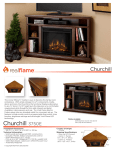

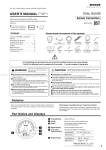
![XL[2] Technical Reference – Hardware](http://vs1.manualzilla.com/store/data/005956150_2-4515f3a1b925b4223206cf04092ab5bd-150x150.png)
